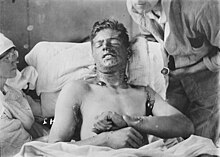Chemical burn


A chemical burn occurs when living tissue is exposed to a corrosive substance such as a strong acid or base. Chemical burns follow standard burn classification and may cause extensive tissue damage. The main types of irritant and/or corrosive products are: acids, bases, oxidizers, solvents, reducing agents and alkylants. Additionally, chemical burns can be caused by some types of chemical weapons e.g. vesicants such as mustard gas and Lewisite, or urticants such as phosgene oxime.
Chemical burns may:
- need no source of heat,
- occur immediately on contact,
- be extremely painful, or
- not be immediately evident or noticeable
The exact symptoms of a chemical burn depend on the chemical involved. Symptoms include itching, bleaching or darkening of skin, burning sensations, trouble breathing, coughing blood, tissue necrosis, and death. Common sources of chemical burns include silver nitrate (AgNO3), hydrochloric acid (HCl), lye (NaOH), and lime (CaO). Chemical burns may occur through direct contact on body surfaces including skin and eyes, inhalation, and ingestion. Chemical fabrication, mining, medicine, and related professional fields are examples of occupations where chemical burns may occur.
